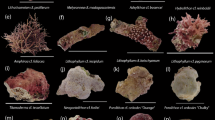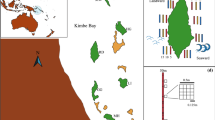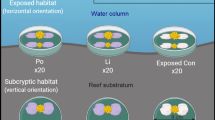Abstract
The recruitment of algae is a critical process during algal colonization and invasions, including coral-to-algal phase shifts. Although algae are widely assumed to colonize and kill corals, there is very little known about the recruitment dynamics of coral reef algae. This study tested the ability of two dominant macroalgae (Fucales including Sargassum spp. and Lobophora variegata) to settle and grow on healthy coral tissue. The study also explored the effects of interactions with prior occupants, and of abiotic substrate properties (texture, and ceramic and carbonate material). The results indicate that healthy corals were able to prevent attachment or survival of recruits of these macroalgae. This is a significant point, since it suggests that the replacement of corals by algae may often require prior stress or death in the coral tissue. Pre-conditioning of plates at different sites had some effects, but these were relatively minor, whereas there was considerable variation within sites. Some of this variation appeared to be related to the amount of turf algae or crustose coralline algae on the plates. Recruitment was generally, but not always, higher on plates with rougher texture. Overall, this preliminary exploration indicates considerable potential for variability in outcomes of algal colonization, with implications for the dynamics of algal invasions. In particular, the results do not support suggestions that planktonic algal propagules can directly settle on and colonize healthy coral tissue.



Similar content being viewed by others
References
Airoldi L (2000) Effects of disturbance, life histories, and overgrowth on coexistence of algal crusts and turfs. Ecology 81:798–814
Amsler CD, Reed DC, Neushul M (1992) The microclimate inhabited by macroalgal propagules. Br Phycol J 27:253–270
Anderson MJ, Underwood AJ (1994) Effects of substratum on the recruitment and development of an intertidal estuarine fouling assemblage. J Exp Mar Biol Ecol 184:217–236
Ang PO (1985) Studies on the recruitment of Sargassum spp. (Fucales: Phaeophyta) in Balibago, Calatagan, Philippines. J Exp Mar Biol Ecol 91:293–301
Barnes H, Topinka JA (1969) Effects of the nature of the substratum on the force required to detach a common littoral alga. Am Zool 9:753–758
Bell PRF, Elmetri I (1995) Ecological indicators of large-scale eutrophication in the Great Barrier Reef. Ambio 24:208–215
Benedetti-Cecchi L, Cinelli F (1992) Effects of canopy cover, herbivores and substratum type on patterns of Cystoseira spp. settlement and recruitment in littoral rockpools. Mar Ecol Prog Ser 90:183–191
Brawley SH, Johnson LE (1991) Survival of fucoid embryos in the intertidal zone depends upon developmental stage and microhabitat. J Phycol 27:179–186
Caley MJ, Carr MH, Hixon MA, Hughes TP, Jones GP, Menge BA (1996) Recruitment and the local dynamics of open marine populations. Annu Rev Ecol Syst 27:477–500
Carpenter RC (1990) Mass mortality of Diadema antillarum. I. Long-term effects on sea urchin population-dynamics and coral reef algal communities. Mar Biol 104:67–77
Carpenter RC, Williams SL (1993) Effects of algal turf canopy height and microscale substratum topography on profiles of flow speed in a coral forereef environment. Limnol Oceanogr 38:687–694
Chapman ARO (1990) Effects of grazing, canopy cover and substratum type on the abundances of common species of seaweeds inhabiting littoral fringe tide pools. Bot Mar 33:319–326
Clifton KE (1997) Mass spawning by green algae on coral reefs. Science 275:1116–1118
Creed JC, Norton TA, Harding SP (1996) The development of size structure in a young Fucus serratus population. Eur J Phycol 31:203–209
de Ruyter van Steveninck ED, Breeman AM (1987) Deep water populations of Lobophora variegata (Phaeophyceae) on the coral reef of Curacao: influence of grazing and dispersal on distribution patterns. Mar Ecol Prog Ser 38:241–250
Diaz-Pulido G, Diaz JM (1997) Algal assemblages in lagoonal reefs of Caribbean oceanic atolls. Proc 8th Int Coral Reef Symp 1:827–832
Diaz-Pulido G, McCook LJ (2002) The fate of bleached corals: patterns and dynamics of algal recruitment. Mar Ecol Prog Ser 232:115–128
Diaz-Pulido G, McCook LJ (2003) Relative roles of herbivory and nutrients in the recruitment of coral reef seaweeds. Ecology 84:2026–2033
Fabricius KE, De’ath G (2001) Environmental factors associated with the spatial distribution of crustose coralline algae on the Great Barrier Reef. Coral Reefs 19:303–309
Figueiredo MAO, Norton TA, Kain (Jones) JM (1997) Settlement and survival of epiphytes on two intertidal crustose coralline alga. J Exp Mar Biol Ecol 213:247–260
Fletcher RL, Callow ME (1992) The settlement, attachment and establishment of marine algal spores. Br Phycol J 27:303–329
Hardy FG, Moss BL (1979) The effects of the substratum on the morphology of the rhizoids of Fucus germlings. Estuaries Coastal Mar Sci 9:577–584
Harlin MM, Lindbergh JM (1977) Selection of substrata by seaweeds: optimal surface relief. Mar Biol 40:33–40
Hixon MA, Brostoff WN (1985) Substrate characteristics, fish grazing, and epibenthic reef assemblages of Hawaii. Bull Mar Sci 37:200–213
Hughes TP (1994) Catastrophes, phase-shifts and large-scale degradation of a Caribbean coral reef. Science 265:1547–1551
Hughes TP, Baird AH, Dinsdale EA, Motschaniwskyj NA, Pratchett MS, Tanner JE, Willis BL (2000) Supply-side ecology works both ways: the link between benthic adults, fecundity, and larval recruits. Ecology 81:2241–2249
Johnson CR, Mann KH (1986) The crustose coralline alga, Phymatolithon Foslie, inhibits the overgrowth of seaweeds without relying on herbivores. J Exp Mar Biol Ecol 96:127–146
Johnson LE (1994) Enhanced settlement on microtopographical high points by the intertidal red alga Halosaccion glandiforme. Limnol Oceanogr 39:1893–1902
Jompa J, McCook LJ (2002a) Effects of competition and herbivory on interactions between a hard coral and a brown alga. J Exp Mar Biol Ecol 271:25–39
Jompa J, McCook LJ (2002b) The effects of nutrients and herbivory on competition between a hard coral (Porites cylindrica) and a brown alga (Lobophora variegata). Limnol Oceanogr 47:527–534
Keats DW, Knight MA, Pueschel CM (1997) Antifouling effects of epithallial shedding in three crustose coralline algae (Rhodophyta, Coralinales) on a coral reef. J Exp Mar Biol Ecol 213:281–293
Kendrick GA (1991) Recruitment of coralline crusts and filamentous turf algae in the Galapagos archipelago: effect of simulated scour, erosion and accretion. J Exp Mar Biol Ecol 147:47–63
Kendrick GA, Walker DI (1995) Dispersal of propagules of Sargassum spp. (Sargassaceae: Phaeophyta): observations of local patterns of dispersal and consequences for recruitment and population structure. J Exp Mar Biol Ecol 192:273–288
Lang JC, Chornesky EA (1990) Competition between scleractinian reef corals—a review of mechanisms and effects. In: Dubinsky Z (ed) Ecosystems of the world, Vol 25. Coral reefs. Elsevier, Amsterdam, pp 209–252
Lapointe BE (1997) Nutrient thresholds for bottom-up control of macroalgal blooms on coral reefs in Jamaica and southeast Florida. Limnol Oceanogr 42:1119–1131
Lewis SM (1986) The role of herbivorous fishes in the organization of a Caribbean reef community. Ecol Monogr 56:183–200
Littler DS, Littler MM (2000) Caribbean reef plants. Offshore Graphics, Washington
Littler MM, Littler DS (1997) Disease-induced mass mortality of crustose coralline algae on coral reefs provides rationale for the conservation of herbivorous fish stocks. Proc 8th Int Coral Reef Symp 1:719–724
Martin-Smith KM (1993) The phenology of four species of Sargassum at Magnetic Island, Australia. Bot Mar 36:327–334
McClanahan TR, McField M, Huitric M, Bergman K, Sala E, Nystrom M, Nordemar I, Elfwing T, Muthiga NA (2001) Responses of algae, corals and fish to the reduction of macroalgae in fished and unfished patch reefs of Glovers Reef Atoll, Belize. Coral Reefs 19:367–379
McCook LJ (1996) Effects of herbivores and water quality on Sargassum distribution on the central Great Barrier Reef: cross-shelf transplants. Mar Ecol Prog Ser 139:179–192
McCook LJ (1997) Effects of herbivory on zonation of Sargassum spp. within fringing reefs of the central Great Barrier Reef. Mar Biol 129:713–722
McCook LJ (1999) Macroalgae, nutrients and phase shifts on coral reefs: scientific issues and management consequences for the Great Barrier Reef. Coral Reefs 18:357–367
McCook LJ (2001) Competition between corals and algal turfs along a gradient of terrestrial influence in the nearshore central Great Barrier Reef. Coral Reefs 17:419–425
McCook LJ, Chapman ARO (1993) Community succession following massive ice-scour on a rocky intertidal shore: recruitment, competition and predation during early, primary succession. Mar Biol 115:565–575
McCook LJ, Jompa J, Diaz-Pulido G (2001) Competition between corals and algae on coral reefs: a review of evidence and mechanisms. Coral Reefs 19:400–417
McCook LJ, Price IR, Klumpp DW (1997) Macroalgae on the GBR: causes or consequences, indicators or models of reef degradation? Proc 8th Int Coral Reef Symp 2:1851–1856
Miller MW, Hay ME, Miller SL, Malone D, Sotka EE, Szmant AM (1999) Effects of nutrients versus herbivores on reef algae: A new method for manipulating nutrients on coral reefs. Limnol Oceanogr 44:1847–1861
Morrison D (1988) Comparing fish and urchin grazing in shallow and deeper coral reef algal communities. Ecology 69:1367–1382
Norton TA (1983) The resistance to dislodgement of Sargassum muticum germlings under defined hydrodynamic conditions. J Mar Biol Assoc UK 63:181–193
Norton TA, Fetter R (1981) The settlement of Sargassum muticum propagules in stationary and flowing water. J Mar Biol Assoc UK 61:929–940
Price IR (1989) Seaweed phenology in a tropical Australian locality (Townsville, North Queensland). Bot Mar 32:399–406
Reed DC (1990) The effects of variable settlement and early competition on patterns of kelp recruitment. Ecology 71:776–787
Santelices B (1990) Patterns of reproduction, dispersal and recruitment in seaweeds. Oceanogr Mar Biol Annu Rev 28:177–276
Santelices B, Varela D (1994) Abiotic control of reattachment in Gelidium chilense (Montagne) Santelices & Montalva (Gelidiales; Rhodophyta). J Exp Mar Biol Ecol 177:145–155
Scott FJ, Russ GR (1987) Effects of grazing on species composition of the epilithic algal community on coral reefs of the central Great Barrier Reef. Mar Ecol Prog Ser 39:293–304
Smith JE, Smith CM, Hunter CL (2001) An experimental analysis of the effects of herbivory and nutrient enrichment on benthic community dynamics on a Hawaiian reef. Coral Reefs 19:332–342
Steneck RS (1997) Crustose corallines, other algal functional groups, herbivores and sediments: complex interactions along reef productivity gradients. Proc 8th Int Coral Reef Symp 1:695–700
Stiger V, Payri CE (1999) Spatial and temporal patterns of settlement of the brown macroalgae Turbinaria ornata and Sargassum mangarevense in a coral reef on Tahiti. Mar Ecol Prog Ser 191:91–100
Underwood AJ, Fairweather PG (1989) Supply-side ecology and benthic marine assemblages. Trends Ecol Evol 4:16–20
Van Tamelen PG, Stekoll MS (1997) The role of barnacles in the recruitment and subsequent survival of the brown alga, Fucus gardneri (Silva). J Exp Mar Biol Ecol 208:227–238
Wilkinson CR (2002) Executive summary. In: Wilkinson CR (ed) Status of coral reefs of the world: 2002. Australian Institute of Marine Science, Townsville, pp 7–31
Worm B, Chapman ARO (1998) Relative effects of elevated grazing pressure and competition from a red algal turf on two post-settlement stages of Fucus evanescens C. Ag. J Exp Mar Biol Ecol 220:247–268
Wright JT, Steinberg PD (2001) Effect of variable recruitment and post-recruitment herbivory on local abundance of a marine alga. Ecology 82:2200–2215
Author information
Authors and Affiliations
Corresponding author
Additional information
Communicated by Topic Editor D. Barnes
Rights and permissions
About this article
Cite this article
Diaz-Pulido, G., McCook, L.J. Effects of live coral, epilithic algal communities and substrate type on algal recruitment. Coral Reefs 23, 225–233 (2004). https://doi.org/10.1007/s00338-004-0370-5
Received:
Accepted:
Published:
Issue Date:
DOI: https://doi.org/10.1007/s00338-004-0370-5




